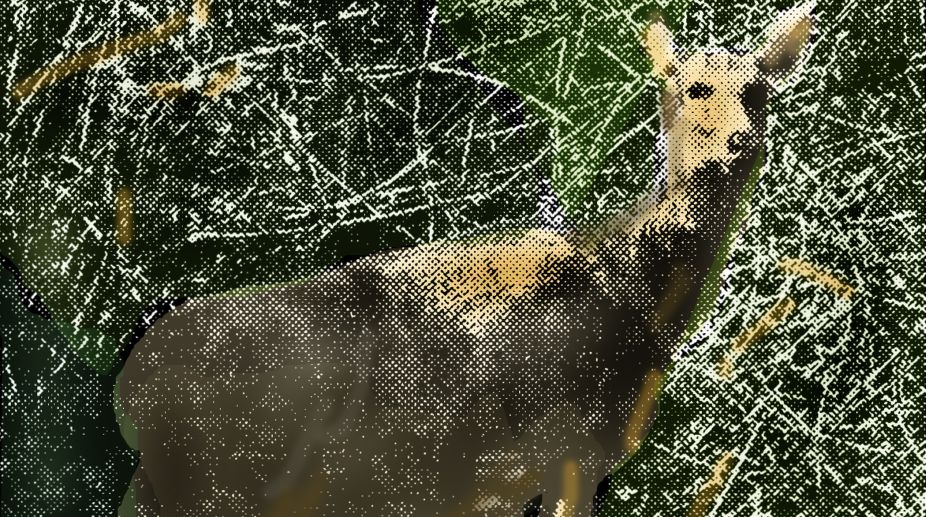A new era in photography: How low-light tech is redefining smartphone cameras
The landscape of smartphone technology is ever-evolving, with continuous innovations reshaping every facet of these omnipresent devices.

Deer.
IN the dip between two forested hillocks I know, there is a thin, meandering stream, narrow enough in places to be leapt across, and nowhere really deep.
In summer this stream is dry, except for a few shaded pools, but it retains sufficient subsoil moisture to support a dense belt of vegetation along the bank for almost a furlong, a few well-grown trees, many flourishing bushes, brakes of screwpine and at a bend clumps of the giant bamboo.
In April, from one of the hillocks between which this stream flows, I saw some movement in the bushes along its bank, and sitting down, scrutinised the patch of Ardisia through my binoculars.
Advertisement
I could see only something like a dark, broad leaf twitching, but knew at once that it was a sambar’s ear. After awhile the sambar, which was feeding on the juicy stems of the bushes, came more into view and I saw that the hind was really big, dark brown and big with a large sore patch at the throat. I was surprised at the massiveness of her body till I realised that she was gravid, and heavy with her burden.
I spent the next three days watching this hind from my observation point on the hillside, through glasses, and never saw any other forest animal approach that cover, no other sambar or other deer, or gaur, or even an errant mongoose.
Actually, I was only a hundred yards away, and though well hidden could clearly see even the small birds in the treetops through my powerful binoculars.The sambar was only to be seen occasionally, and never exposed herself fully.
She was visible as an indistinct shadow behind the bushes on which she was feeding, though at times, I could see her head or back or some part of her through the twigs and foliage, and the culms of the bamboo clumps which seemed to be her favourite cover. Even when drinking from one of the pools below the cover, she never gave me a clear view.
On the second day, finding my vigil rather boring, I amused myself by rigging up a powerful minus lens in front of the tele-lens of my camera, a crude arrangement involving the securing of the camera body to a rock with tough twiners, and gaining the considerable extra extension needed by affixing the lens combination to a box of stout cardboard.
To my surprise, I got a clear picture with this contraption (the one reproduced here) when the sambar came out of a dense patch of lantana momentarily, but I did not persist with the photography as it was a noise and cumbersome business.
From the afternoon of the second day to the next afternoon, that hind stayed put in the cover, not showing so much as an ear. That she was still there I could sense, more than actually see, from the agitation of some leafy twig, or from a shadowy, recumbent background to the delicate tracery of the bamboo leaves and twigs.
Then, about 4 o’clock on the third day, she rose from behind the bamboo and stepped two paces across a clear patch to the water to drink; through the twigs at the base of the bamboo clump I could now see a little golden head, the head of her newborn fawn, but I had only a glimpse of it before the hind went back to the clump from the pool, and lay down again.
I had to leave the area in the evening, but to try and approach closer would mean panicking the hind in her fancied security, and suppressing the photographer in me, I left quietly.
Ten days later, I was able to revisit that stream, and cautiously topping the hillock from the other side and climbing down to my vantage point sheltered by bushes, I was delighted to see that the sambar and her fawn were still there.
The fawn now seemed quite vigorous and was quick on its feet, though it kept very close to its mother’s side, but the hind was much less shy and was no longer hiding in cover.
A yearling hind was with her now, perhaps a daughter from the previous season. The party ranged freely along the banks of the stream, browsing choosily and keeping more or less together.
I have often seen sambar hinds with very young fawns, accompanied by a sub-adult hind or stag, sometimes even two; apparently the mother keeps in touch with her young even after they are sufficiently grown up to shift for themselves, but when giving birth the hind keeps away from the family and prefers seclusion and privacy.
This was published on 21 August 1967
Advertisement